Ever spilled a drop of tung oil and wondered, “Does this ever go bad?” Dive in to unravel the mystery of its shelf life.
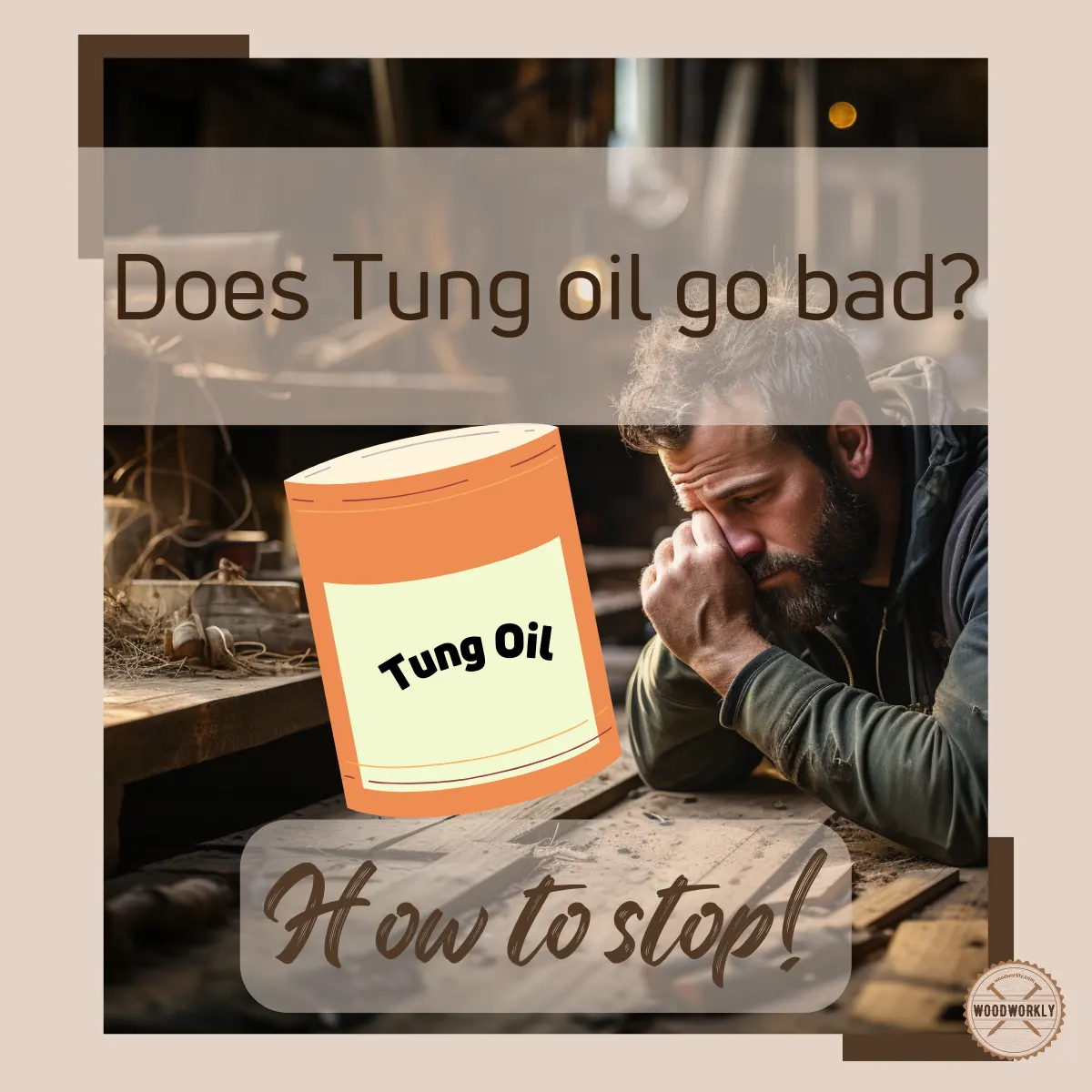
In my years as a woodworker, one question that stumped me early on was, “Why does my tung oil go bad?” Even as an experienced craftsman, I found myself facing a spoiled batch after several projects.
Driven by curiosity, I sought out experts to uncover the mystery behind its degradation.
Join me as I share what I learned about why tung oil can spoil and how to prevent it.
So, let’s find out, Does Tung oil go bad?
Yes, tung oil can go bad. Over time, especially if improperly stored, tung oil can degrade, becoming rancid or changing in consistency. For optimal shelf life, store in a cool, dark place and ensure the container is tightly sealed. Always check for off smells or unusual textures before use.
But that’s a quick snapshot of the question.

So, in this article, I’ll explore, does tung oil go bad, how can you tell if tung oil is bad, how tung oil age, how to stop tung oil from going bad, and so much more.
Furthermore, I’ll answer some frequently asked questions as well.
So, let’s jump in!
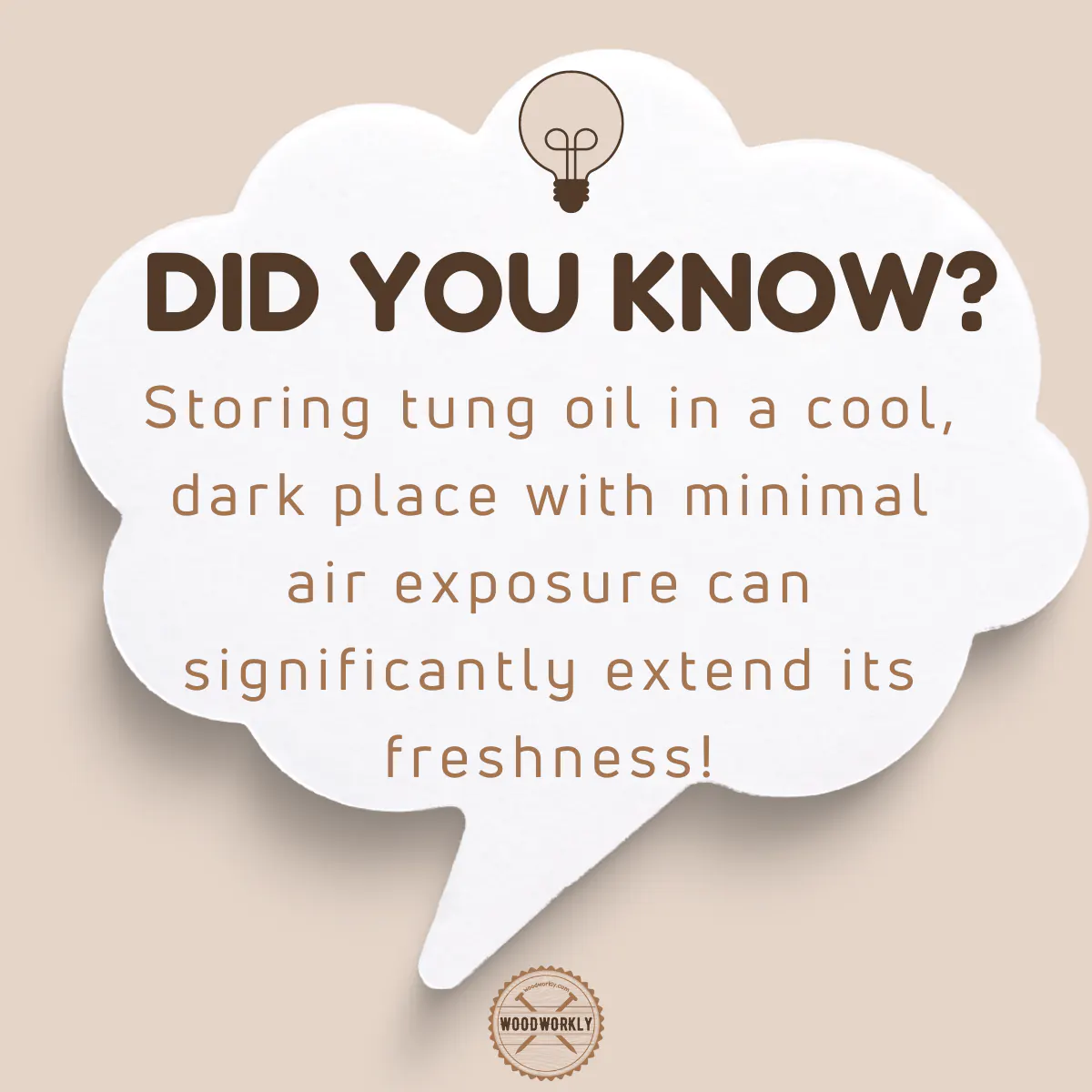
Can Tung Oil Go Bad?
Yes, Tung oil can go bad like many other natural products, tung oil has the potential to deteriorate over time.
The journey of understanding the shelf life of tung oil is fascinating and essential for those who rely on its incredible benefits.
The Natural Life Cycle of Tung Oil
To understand whether tung oil can go bad, it’s crucial to familiarize oneself with its origin.
Derived from the seeds of the tung tree (Vernicia fordii) native to China, this oil has been the go-to protective finish for wood and other surfaces for centuries.
But why is that important? Well, like all natural products, exposure to various environmental factors can affect its quality.
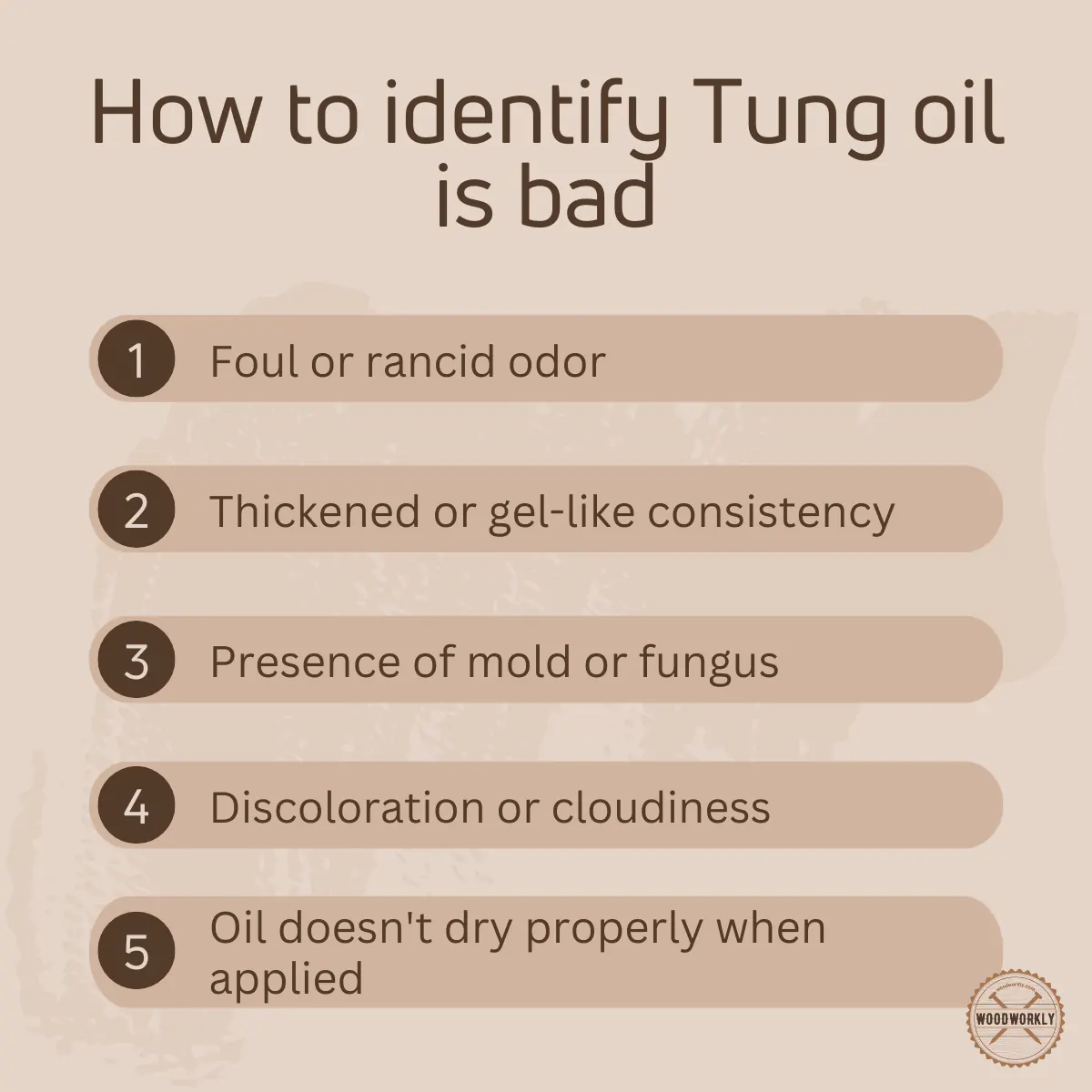
Does Tung Oil Get Old?
Yes, tung oil gets old when it is not stored well. You keep keeping the tung oil can in a cool dry place without letting the oil get contact with outside air.
Make sure to replace the air of the can with some other materials to minimize the air in the container.
When the can is not opened or properly sealed tung oil has good shelf life just like teak oil and Danish oil.
After using the tung oil for the first time, its shelf life can be 2 or more years when stored properly.
If tung oil gets contact or mixes with moisture, water, and atmospheric oxygen, the oil will get contaminated and lose its strength.
When tung oil gets contact with outside air, it will go through an oxidation reaction forming hard catalysts which reduce the performance of tung oil.
Once the oil gets fully oxidized and hardened, there’s no use for tung oil. Therefore, sealing can is so important.
Why Does Tung Oil Go Bad?
Ah, the intriguing life of tung oil! Have you ever paused to consider why something as natural and potent as tung oil might lose its charm over time?
Let’s embark on this journey to uncover the reasons behind the aging process of tung oil, and I promise, by the end of it, you’ll have quite a story to share at your next DIY gathering.
The Science Behind It
Tung oil’s beauty lies in its chemical composition. However, the same composition makes it susceptible to degradation.
Polyunsaturated Fats: Tung oil is rich in polyunsaturated fats. While these fats have their benefits, they are a double-edged sword.
They’re reactive, which means they easily undergo oxidation when exposed to oxygen in the air.
It’s a bit like how avocados turn brown soon after you slice them open.
External Factors: The Usual Suspects
Air Exposure
Have you ever noticed how an uncorked wine changes its flavor profile when left open?
This is because of oxidation. Similarly, when tung oil comes in contact with air, especially after its container is opened, it starts to oxidize, leading to an increase in viscosity and a change in its properties.
One of my DIY buddies likened this to how a vibrant, fresh paint color can dull when left open for too long.
Sunlight and Heat
Just as how we protect ourselves with sunglasses and hats in the bright sun, tung oil too needs protection.
Sunlight accelerates the breakdown of the oil’s chemical structure, leading to its deterioration.
And let’s not forget about heat. Storing tung oil in a hot place can escalate its degradation process.
It’s almost like keeping an ice cream cone under the sun; we all know that’s not going to end well!
Contaminants
Often, when using tung oil, brushes or rags might accidentally introduce contaminants back into the container.
These contaminants, whether they be dirt, moisture, or even small wood particles, can affect the purity of the tung oil.
I remember a time when a friend, in a hurry, accidentally introduced sawdust into his tung oil container.
The result? The oil didn’t just thicken; it formed clumps!
Packaging Matters
Inefficient Seals
One would think that a container’s job ends once it holds the oil. Not quite! The efficiency of the container seal plays a significant role in the longevity of tung oil.
A loosely sealed container invites more air, leading to quicker oxidation.
It’s somewhat akin to those times when you thought you sealed that bag of chips tightly, only to find them stale the next day.
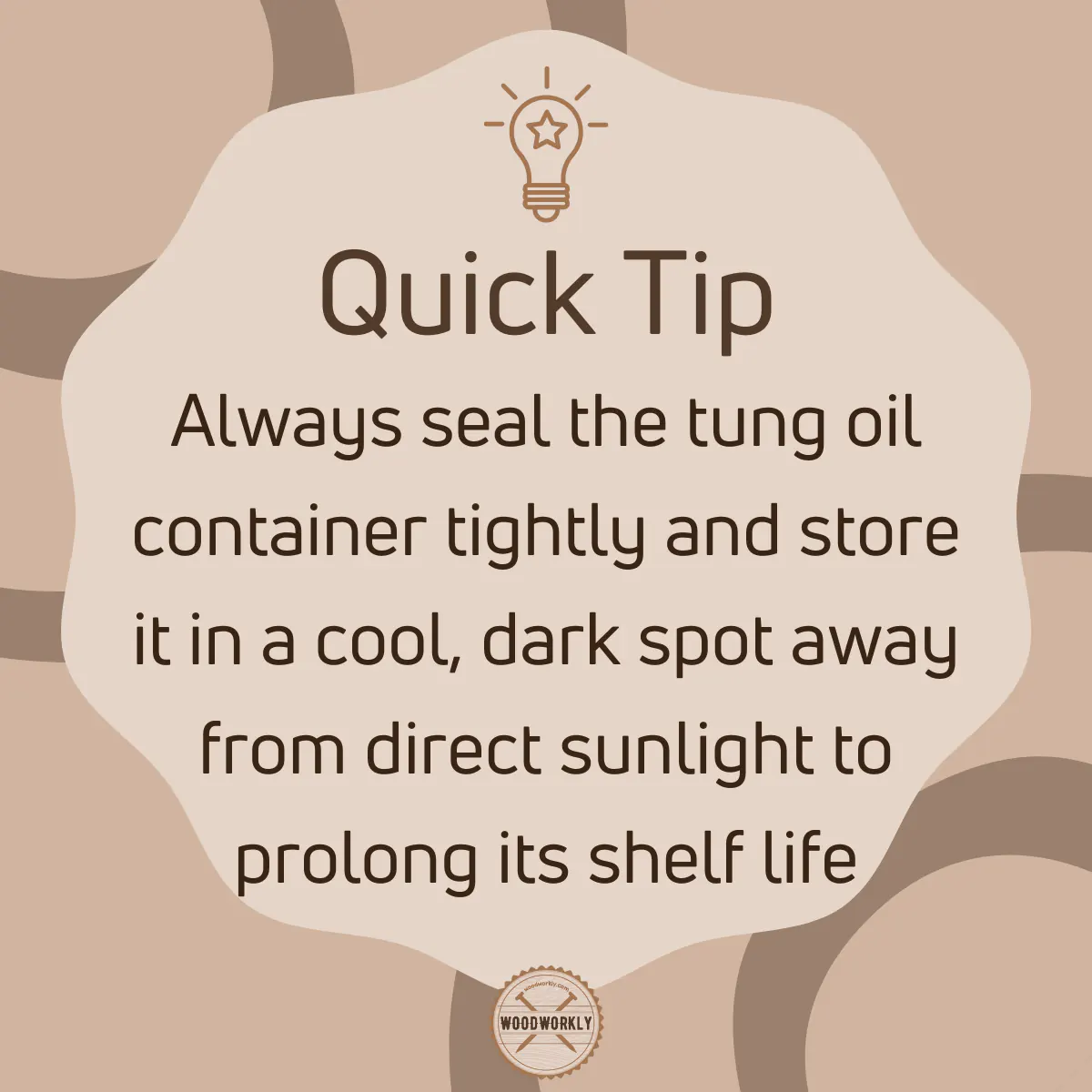
How To Stop Tung Oil from Getting Bad?
You can prevent tung oil from getting old by preventing contact with outside air, and moisture.
Here’re the methods to stop tung oil from going bad,
- Keep tung oil in a sealed air-free container.
- Keep tung oil away from direct sunlight
- Fill empty space of the tung oil can with pebbles to replace air space.
- Crush-tung oil square can form edges to make it looks full and have no spaces for outside air.
- Replace air space with shielding gas or Bloxygen.
- Keep Tung oil pure without any party crashers.
- Rotate stock
Let’s discuss each of the above methods separately to get a clear idea about how to stop tung oil from going bad.
1. Keep Tung Oil in A Sealed Air-Free Container
After using tung oil for the first time, close its lid tightly without letting outside air go in.
Outside air, moisture and other chemical substances react with tung oil and make the oil contaminated.
Tung oil dries and hardens upon oxidation. So, use a tight lid to keep tung oil for a long time without any contamination issues.
With proper sealing, you’ll be able to keep tung oil easily for around 6 to 7 years.
2. Keep Tung Oil Away From Direct Sunlight
Much like Goldilocks’ porridge, tung oil too has a “just right” temperature. Storing it in a cool, dry place is ideal.
Think of it like preserving a vintage wine or your favorite chocolate – neither too hot nor too cold.
Tung oil and sunlight? Not the best of friends. Keep your oil away from direct sunlight.
I learned this the hard way when I left a bottle in my sunlit garage. Needless to say, the oil wasn’t its best self after that summer.
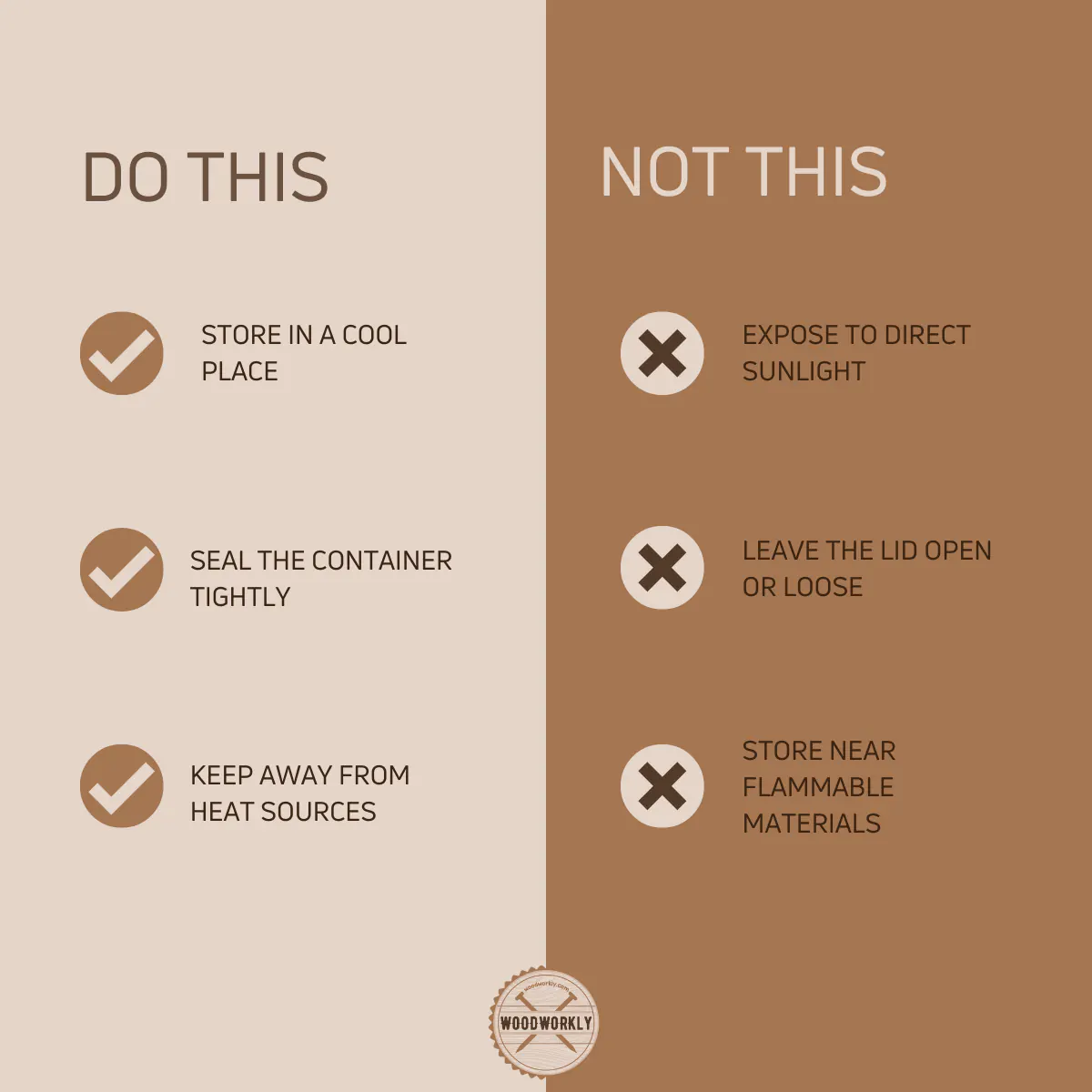
3. Fill the Empty Space Of the Tung Oil Can with Pebbles
After using tung oil, fill the empty space with pebbles to keep the can full. Here pebbles will take up the space of air and prevent air from going inside the can.
With no air inside, tung oil won’t go bad and can increase its shelf life with this method.
You can use marbles or aquarium pebbles for this task. With the addition of pebbles, the oil level gets increased, and appears as if the can is nearly full.
This helps to minimize oxygen levels inside the can.
4. Crush Tung Oil Can
After using tung oil, crush square shapes of tung oil can to increase the oil level and prevent outside air from filling out the spaces.
You should do this carefully without cracking the can.
By crushing the tung oil container from corners, you can make it looks nearly full and keep the air minimal in the container.
5. Add Shielding Gas or Bloxygen
You can use inert gas like Argon to fill up space after using Tung oil to replace oxygen left in the can. Or you can use Bloxygen to displace oxygen left in the can.
You just have to hold the tung oil can lid by hand and insert a little amount of shielding gas into the can and place the lid tightly.
This is the most popular method of preventing tung oil from getting bad or old.
6. Keep Tung Oil Pure Without any Party Crashers
Remember, every time you pour some oil out, you introduce a chance for contaminants to jump in.
Always use clean brushes or rags and avoid direct pouring.
Using a funnel can be a lifesaver! I vividly recall an incident where a buddy of mine mistakenly let some paint flecks get into his tung oil.
It became a cautionary tale in our DIY group.
7. Rotate Stock
If you have multiple containers, use the oldest stock first. It’s the same principle as rotating perishables in your pantry.
This ensures you’re always using the freshest oil available.
Now you know to avoid tung oil from getting bad in detail.
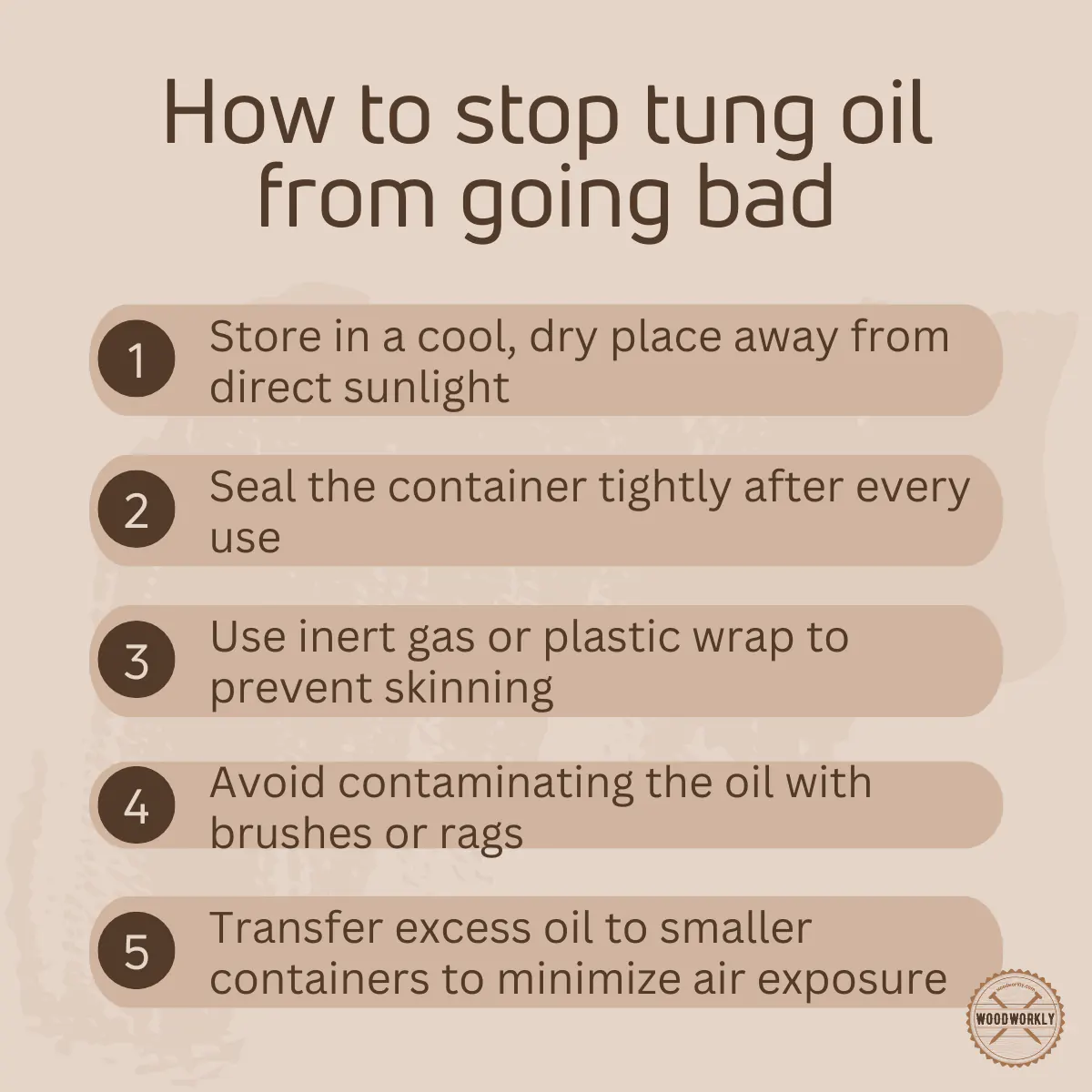
How Can You Tell If Tung Oil Is Bad?
When tung oil is bad, it develops a characteristic unpleasant odor that happens due to oil rotting or spoiling.
Plus, tung oil doesn’t dry well when it went bad.
Tung oil goes bad because of outside air, moisture, and other chemical substances.
They will polymerize the tung oil catalyst and lose its strength. When tung oil gets bad, it appears different than fresh ones.
Here’s a simple test to determine whether your tung oil is bad or not,
- Take a plastic laminate or glass.
- Add Tung oil to the tip of those surfaces
- Angle it for 45 degrees by allowing Tung oil to flow through the surface.
- Then check how long it takes to dry.
If Tung oil dries so well within 4 to 6 hours, it is good to use.
If it doesn’t dry within 12 – 24 hours, sorry to say, Tung oil is already gone bad.
So, as a summary, here’re the tests you can identify when Tung oil is bad.
- Does not dry well
- Unpleasant odor
- Oil is rancid
How Does Tung Oil Age?
Tung oil doesn’t age when it is not contaminated. Not like teak oil or Danish oil, Tung oil doesn’t darken wood over time.
But once it went bad, tung oil may mold and rancid due to the contaminations from environmental elements like moisture, chemicals, and oxygen in the air.
Tung oil has infinite shelf life when it is not opened. But as soon as it opens outside air will go inside the tung oil can and start tung oil aging.
Generally, tung oil lasts for about 2 to 3 years with proper care and with minimum contact with atmospheric oxygen.
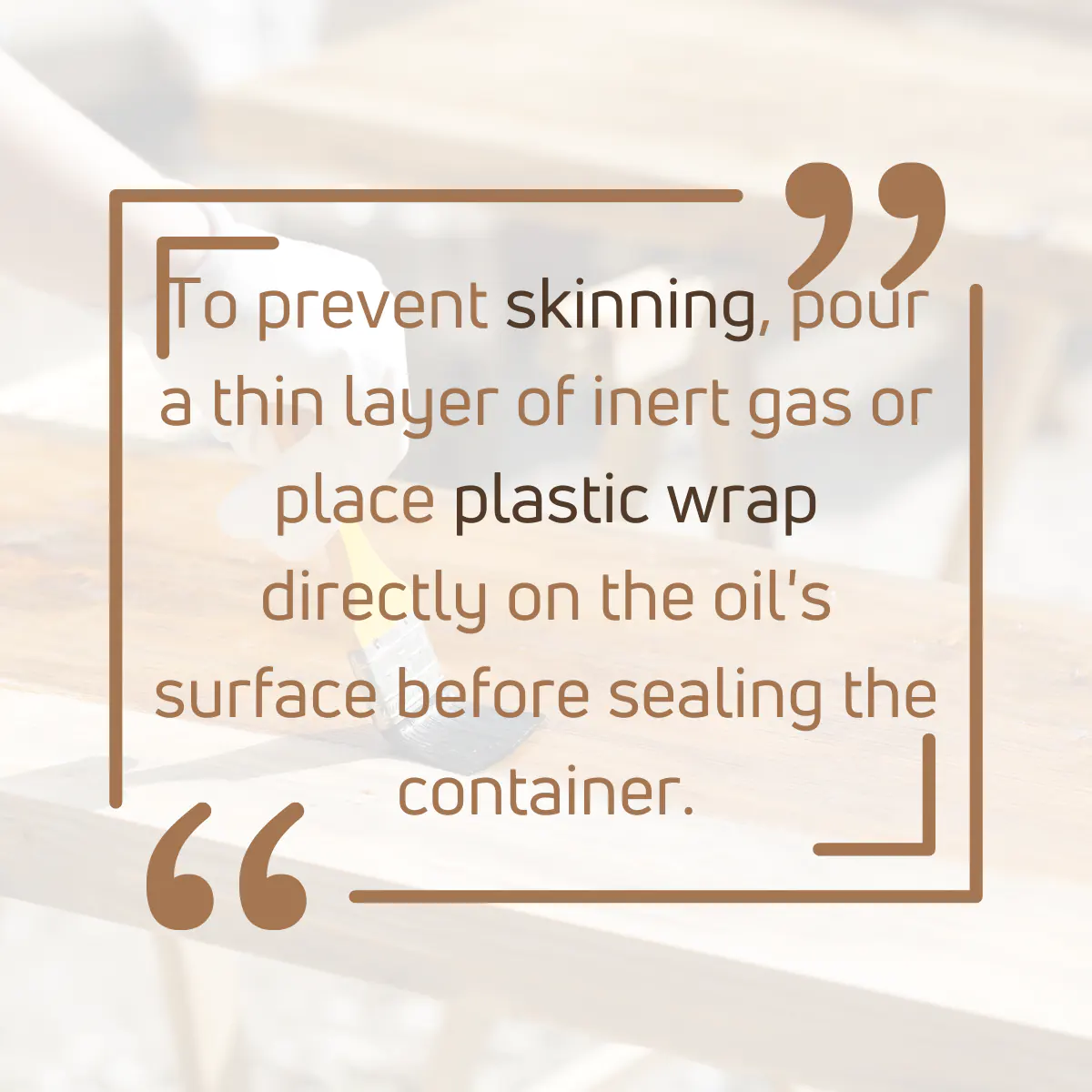
How Long Does Tung Oil Last?
I must admit, the fascinating lifespan of tung oil has been a hot topic during many of my DIY meetups.
We all have that one can in the back of our workshop we’ve forgotten about.
It brings up that age-old question, “Just how long can this liquid gold really last?”
Join me on this journey to uncover the longevity of our beloved tung oil!
1. Unopened Bottles: The Treasure Trove
Ah, the joy of discovering an unopened bottle of tung oil in the attic. It’s like finding an old, unread book on your shelf.
But the question remains – is it still good?
Typically, an unopened can of tung oil can last anywhere from 5 to 10 years if stored properly.
It’s like wine, but remember, just like that Chardonnay, the storage conditions matter a lot.
2. Opened Bottles: The Clock’s Ticking, but Not Too Fast
Once opened, the longevity of tung oil does take a slight hit.
With proper storage and care (remember our above pointers on that?), you’re looking at a healthy 12-18 months of shelf life.
I still remember using an opened can after 15 months for a vintage table restoration – worked like a charm!
3. On the Surface: Protective and Graceful Aging
Here’s where things get a bit magical. When tung oil is applied to a surface, its longevity multiplies.
A well-applied layer of tung oil on wood can last for several years without needing a touch-up.
My grandmother’s dining table, which I restored with her when I was a teenager, still gleams with the same tung oil charm we gave it years ago.
How Long Does Tung Oil Last on Wood?
Tung oil lasts on wood for about 1 to 2 years with proper care and regular maintenance.
Apply tung oil at least once per year on your woodwork or furniture to keep them protected from outside moisture, and other elements while enhancing their natural beauty.
Once tung oil went bad, it will lose its protection and beautiful appearance.
When tung oil is bad, the water will easily penetrate through tung oil layers and start damaging the wood. this will cause wood to rot.
Rotted wood cannot be restored using tung oil, you need to use special products like Flex seal to restore rotted wood.
Make sure to clean tung oil applied furniture surfaces regularly with lint-free cloths to eliminate dust and dirt.
Dust, dirt, grease, and other chemical elements damage tung oil and reduce its lifetime.
4. Sniff and See: The Time-Tested Method
Regardless of what the calendar says, your nose and eyes are your best tools. If the oil smells rancid or has a strange consistency, it’s time to bid adieu.
A friend of mine once insisted on using a questionable can, and let’s just say, it was an odorous experience for all of us involved!
5. What About Pure vs. Modified Tung Oils?
Pure tung oils, in their virgin state, typically last longer.
The modified versions, which have additives or are thinned out, might have a slightly reduced shelf life.
Think of it as the difference between organic and processed foods.
I personally lean towards the pure, but both have their unique charm and lifespan.
How Long Does Tung Oil Last Outdoors?
Tung oil lasts one year outdoors with proper care and regular maintenance.
Reapply tung oil by removing previous ones at least once per year to protect your outdoor furniture from elements like moisture, insect attacks, temperature variations, rotting, and more.
With rain, humidity, and other environmental factors, tung oil coatings tend to wear off. You can prevent this by reapplying tung oil as soon as when you notice the difference in the wood finish.
The waterproofing ability of tung oil will reduce dramatically when it hits more than one year.
To apply tung oil over your outdoor furniture, you need to keep the tung oil can in a cool dry place with proper storing techniques.
If tung oil already went bad when you think to apply after one year of use, you’ll have to spend on a new can, which is a waste of money.
You need to care for outside furniture that was protected by tung oil twice as much as indoor furniture since they regularly get impacted by harsh weather.
Does Tung Oil Get Rancid?
Tung oil doesn’t go rancid like other oil finishes. Therefore, you’ll be able to keep it fresh as new for so long.
But once the oil gets bad due to the contamination with oxygen, moisture, and other elements, it may go rancid by losing performance.
How Long Can Tung Oil Be Stored?
Unopened tung oil can be stored for even more than decades. Once it is opened and properly sealed by minimizing oxygen level, you will be able to store tung oil for 2 to 3 years.
But without proper storing the oil will get oxidized by outside air and won’t last even 2 – 3 months.
Proper storing is the key to extending the shelf life of tung oil.
Problems That Occur When Tung Oil Go Bad With Solutions
When you apply bad tung oil on wood, there’re several issues you will notice.
Some of them are easy to cure, but others don’t so better to check whether your tung oil is in a fresh state before applying it to your loving furniture.
Here’re some common issues that occur when tung oil is bad with proper solutions.
1. Tung Oil Is Sticky
This is a common issue that happens because of using outdated, bad, contaminated tung oil. Usually, tung oil dries and fully cures within 10 – 12 hours under normal environmental conditions.
But sometimes tung oil coats don’t dry quickly and keep sticky for more than weeks.
Here’re the possible reasons why tung oil is sticky for so long.
- Using the incorrect process when applying oil.
- Not getting enough time to dry between coats.
- Tung oil is already going bad.
Apply tung oil along the direction of the wood for better absorption without making a mess. Plus, make sure to check the status of tung oil to confirm whether it’s good to use.
Solution:
Wipe the entire surface by soaking a lint-free soft cloth in mineral spirit to eliminate tung oil coatings.
Then start with a fresh tung oil can by following the correct application guidelines as in the manufacturer’s instructions.
2. Tung Oil Is Uneven
Uneven tung oil surface occurs due to improper application processes and when tung oil is bad to use.
When tung oil is bad some tung oils were already polymerized due to atmospheric oxygen and they don’t absorb well into the surface. This may cause surface blotchiness and bubbles.
Solution:
Wipe the entire surface with mineral spirit to eliminate tung oil coatings and start with a fresh tung oil can.
Congrats folks! Now you know does tung oil go bad and how to avoid that using simple methods.
So, let’s answer some frequently asked questions.
FAQs
How long can I expect an opened can of tung oil to last?
An opened can of tung oil, with proper storage, typically lasts around 12-18 months. Always trust your senses: if something seems off, it probably is!
Does pure tung oil have a longer shelf life than modified versions?
Yes, pure tung oils, being in their natural state, often outlast their modified counterparts. Modified versions, with additives, might not age as gracefully.
How can I extend the shelf life of my tung oil?
Storing it in a cool, dark place and ensuring the lid is sealed tightly can help. Avoiding direct sunlight and temperature fluctuations is key!
Is there a difference in shelf life between tung oil in a metal can vs. a plastic container?
Both containers, if sealed properly, should offer similar protection. However, ensure that the container is stored in optimal conditions for the best shelf life.
Can cold or freezing temperatures spoil tung oil?
Cold temperatures can cause tung oil to thicken or even solidify. If it returns to normal consistency at room temperature and smells okay, it’s typically still good to use.
Is there any way to rejuvenate old tung oil?
While there’s no magic fix, sometimes gently heating old oil can restore some of its consistency. But if it smells rancid, it’s best to replace it.
Can I mix old and new tung oil?
Mixing isn’t generally recommended as the older oil might compromise the quality of the fresh batch. Always prioritize using fresh tung oil for the best results.
Did I cover all you wanted to know about: Does Tung Oil Go Bad?
In this article, I have deeply discussed does tung oil go bad and how to stop that using proper storing techniques.
Plus I have talked about how can you tell if tung oil is bad and how to increase its shelf life as well.
Tung oil goes bad when it is not stored well. Tung oil has a high shelf life when the can is tightly closed and keeps the air at a minimum. Fill the tung oil can with pebbles or crush the square sides of the container to make it full. Or put shielding gas or Bloxygen to replace the air space in the tung can.
Furthermore, I’ve answered some frequently asked questions as well.
Hope you have gained good knowledge about the shelf life of tung oil.
Make sure to apply things you have learned in this article when storing and using tung oil to keep it fresh as new for a long time.
Happy woodworking!